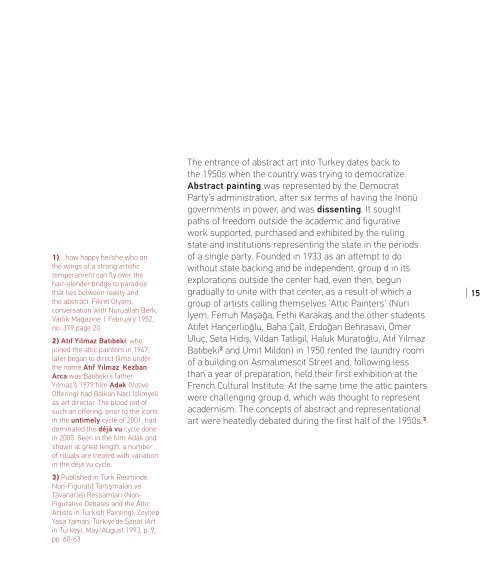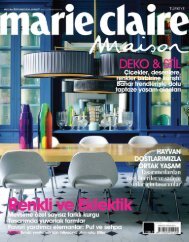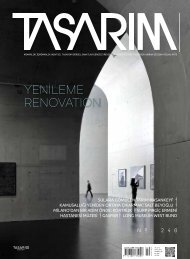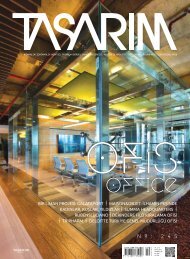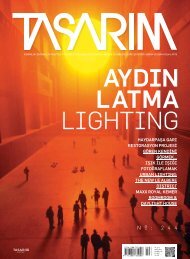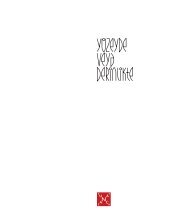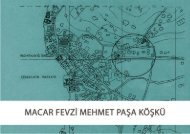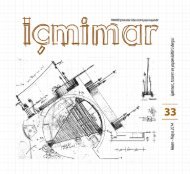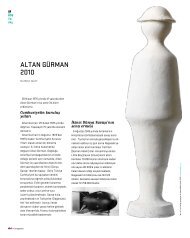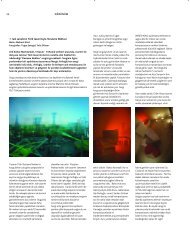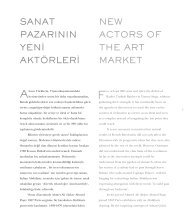SURET-SİZ
Tunca Sanat'ın 15 Aralık 2010 - 30 Ocak 2011 tarihleri arasında düzenlediği “Suret-siz’’ adlı sergisi için Mahmut Nüvit'in kaleme aldığı yazısı...
Tunca Sanat'ın 15 Aralık 2010 - 30 Ocak 2011 tarihleri arasında düzenlediği “Suret-siz’’ adlı sergisi için Mahmut Nüvit'in kaleme aldığı yazısı...
You also want an ePaper? Increase the reach of your titles
YUMPU automatically turns print PDFs into web optimized ePapers that Google loves.
1) …how happy he/she who on<br />
the wings of a strong artistic<br />
temperament can fly over the<br />
hair-slender bridge to paradise<br />
that lies between reality and<br />
the abstract. Fikret Otyam,<br />
conversation with Nuruallah Berk,<br />
Varlık Magazine 1 February 1952,<br />
no. 379 page 20<br />
2) Atıf Yılmaz Batıbeki, who<br />
joined the attic painters in 1947,<br />
later began to direct films under<br />
the name Atıf Yılmaz. Kezban<br />
Arca was Batıbeki’s father.<br />
Yılmaz’s 1979 film Adak (Votive<br />
Offering) had Balkan Naci İslimyeli<br />
as art director. The blood red of<br />
such an offering, prior to the icons<br />
in the untimely cycle of 2001, had<br />
dominated the déjà vu cycle done<br />
in 2000. Seen in the film Adak and<br />
shown at great length, a number<br />
of rituals are treated with variation<br />
in the déjà vu cycle.<br />
3) Published in Türk Resminde<br />
Non-Figuratif Tartışmaları ve<br />
Tavanarası Ressamları (Non-<br />
Figurative Debates and the Attic<br />
Artists in Turkish Painting), Zeynep<br />
Yasa Yaman, Türkiye’de Sanat (Art<br />
in Turkey), May/August 1993, p. 9,<br />
pp. 60-63<br />
The entrance of abstract art into Turkey dates back to<br />
the 1950s when the country was trying to democratize.<br />
Abstract painting was represented by the Democrat<br />
Party’s administration, after six terms of having the Inönü<br />
governments in power, and was dissenting. It sought<br />
paths of freedom outside the academic and figurative<br />
work supported, purchased and exhibited by the ruling<br />
state and institutions representing the state in the periods<br />
of a single party. Founded in 1933 as an attempt to do<br />
without state backing and be independent, group d in its<br />
explorations outside the center had, even then, begun<br />
gradually to unite with that center, as a result of which a<br />
group of artists calling themselves ‘Attic Painters’ (Nuri<br />
İyem, Ferruh Maşağa, Fethi Karakaş and the other students<br />
Atıfet Hançerlioğlu, Baha Çalt, Erdoğan Behrasavi, Ömer<br />
Uluç, Seta Hidiş, Vildan Tatlıgil, Haluk Muratoğlu, Atıf Yılmaz<br />
Batıbeki 2 and Ümit Mildon) in 1950 rented the laundry room<br />
of a building on Asmalımescit Street and, following less<br />
than a year of preparation, held their first exhibition at the<br />
French Cultural Institute. At the same time the attic painters<br />
were challenging group d, which was thought to represent<br />
academism. The concepts of abstract and representational<br />
art were heatedly debated during the first half of the 1950s. 3<br />
| 15


